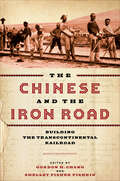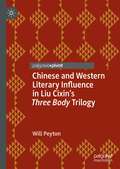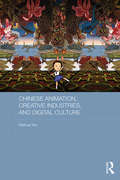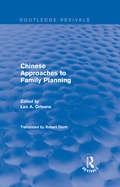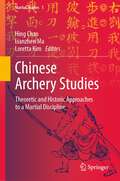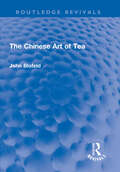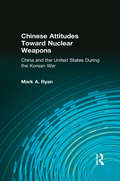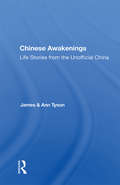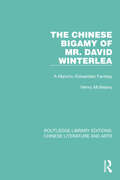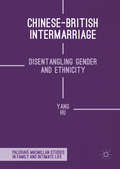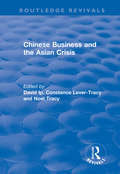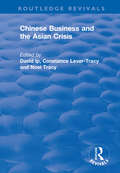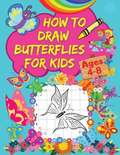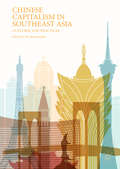- Table View
- List View
The Chinese and the Iron Road: Building the Transcontinental Railroad (Asian America)
by Gordon H. Chang and Shelley Fisher FishkinThe completion of the transcontinental railroad in May 1869 is usually told as a story of national triumph and a key moment for American Manifest Destiny. The Railroad made it possible to cross the country in a matter of days instead of months, paved the way for new settlers to come out west, and helped speed America's entry onto the world stage as a modern nation that spanned a full continent. It also created vast wealth for its four owners, including the fortune with which Leland Stanford would found Stanford University some two decades later. But while the Transcontinental has often been celebrated in national memory, little attention has been paid to the Chinese workers who made up 90 percent of the workforce on the Western portion of the line. The Railroad could not have been built without Chinese labor, but the lives of Chinese railroad workers themselves have been little understood and largely invisible. This landmark volume explores the experiences of Chinese railroad workers and their place in cultural memory. The Chinese and the Iron Road illuminates more fully than ever before the interconnected economies of China and the US, how immigration across the Pacific changed both nations, the dynamics of the racism the workers encountered, the conditions under which they labored, and their role in shaping both the history of the railroad and the development of the American West.
Chinese and Western Literary Influence in Liu Cixin’s Three Body Trilogy (Studies in Global Science Fiction)
by Will PeytonChinese and Western Literary Influence in Liu Cixin’s Three Body Trilogy examines Liu Cixin’s acclaimed trilogy, a Chinese science fiction epic whose translation is exceedingly popular in the Western world. Will Peyton argues that the ingenuity of Liu’s writing is found in its conscious engagement with translated Western fiction rather than, as one might expect, in Chinese language science fiction of the past. The book illustrates how contemporary Chinese fiction, since the economic opening of China in the late 1980s, is deeply and complexly influenced by various strains in Western literary and intellectual thought, an area that scholars of Chinese literature have tended to neglect. Providing a lucid and succinct close-reading and textual analysis of Three Body trilogy, the book also makes reference to broader ideas and themes in modern Chinese and Western intellectual history.
Chinese Animation, Creative Industries, and Digital Culture (Routledge Culture, Society, Business in East Asia Series)
by Weihua WuThis book explores the development of the Chinese animation film industry from the beginning of China’s reform process up to the present. It discusses above all the relationship between the communist state’s policies to stimulate "creative industries", concepts of creativity and aesthetics, and the creation and maintenance , through changing circumstances, of a national style by Chinese animators. The book also examines the relationship between Chinese animation, changing technologies including the rise first of television and then of digital media, and youth culture, demonstrating the importance of Chinese animation in Chinese youth culture in the digital age.
Chinese Animation, Creative Industries, and Digital Culture (Routledge Culture, Society, Business in East Asia Series)
by Weihua WuThis book explores the development of the Chinese animation film industry from the beginning of China’s reform process up to the present. It discusses above all the relationship between the communist state’s policies to stimulate "creative industries", concepts of creativity and aesthetics, and the creation and maintenance , through changing circumstances, of a national style by Chinese animators. The book also examines the relationship between Chinese animation, changing technologies including the rise first of television and then of digital media, and youth culture, demonstrating the importance of Chinese animation in Chinese youth culture in the digital age.
Chinese Approaches to Family Planning (Routledge Revivals)
by Robert Dunn Leo A. OrleansThis title was first published in 1980. Years of experience have shown that the successful introduction of family planning into a rural, tradition-bound society essentially depends on how efficiently the authorities can educate and motivate the targeted population. But while China’s impressive family planning successes in the 1970s have, to a large extent, resulted from innovative methods of communication and motivation, it has also continued to rely on the more orthodox means of persuasion, such as the media, pamphlets, posters, lantern slides, personal testimonies, and so forth. The pattern in a ll the m aterials is very similar: problem, ideological struggle, happy ending. This volume is a look the materials the People' s Health Press printed and distributed of more than 300,000 copies of information on Chinese birth control.
Chinese Approaches to Family Planning (Routledge Revivals)
by Leo A. OrleansThis title was first published in 1980. Years of experience have shown that the successful introduction of family planning into a rural, tradition-bound society essentially depends on how efficiently the authorities can educate and motivate the targeted population. But while China’s impressive family planning successes in the 1970s have, to a large extent, resulted from innovative methods of communication and motivation, it has also continued to rely on the more orthodox means of persuasion, such as the media, pamphlets, posters, lantern slides, personal testimonies, and so forth. The pattern in a ll the m aterials is very similar: problem, ideological struggle, happy ending. This volume is a look the materials the People' s Health Press printed and distributed of more than 300,000 copies of information on Chinese birth control.
Chinese Archery Studies: Theoretic and Historic Approaches to a Martial Discipline (Martial Studies #1)
by Hing Chao Lianzhen Ma Loretta KimThis book, the first research publication on China’s archery culture to appear in the English language, introduces the historic development, key concepts, and research methodologies for archery studies. Archery was the most important weapon of war in pre-modern China; at the same time, archery practice was intimately tied to Confucius’ cultural and pedagogic ideals. Chinese archery was divided into the domains of military archery (wushe) and ritual archery (lishe), and may be further distinguished into han (Chinese) and hu (barbarian) archery traditions. Bringing together the leading scholars in this field, including Ma Mingda, Stephen Selby, Ma Lianzhen, Peter Dekker, and others, this book presents the most comprehensive statement on archery studies to date. In particular, it provides an in-depth survey of archery development during the Qing period and offers a unique cultural perspective to understanding China’s last imperial dynasty—through the lens of Manchu archery.
The Chinese Art of Tea (Routledge Revivals)
by John BlofeldFirst published in 1985, The Chinese Art of Tea is an exploration into the history of tea and the Chinese art of tea, known as ch’a-shu. The book begins by delving into the history and legends surrounding tea before moving on to a study of the Emperor Hui Tsung’s treatise on tea and approaches to tea during the Ming Dynasty. It discusses tea gardens, teahouses, the relationship between tea and ceramics, and the connection between tea and health. The book also features a detailed manual for practising the art of drinking tea, including advice for choosing tea, buying tea, different types of infusion and drinking vessels, and the attitude required for obtaining the fullest satisfaction from tea. The Chinese Art of Tea is ideal for anyone with an interest in the history and art of drinking tea, and the social and cultural history of China.
The Chinese Art of Tea (Routledge Revivals)
by John BlofeldFirst published in 1985, The Chinese Art of Tea is an exploration into the history of tea and the Chinese art of tea, known as ch’a-shu. The book begins by delving into the history and legends surrounding tea before moving on to a study of the Emperor Hui Tsung’s treatise on tea and approaches to tea during the Ming Dynasty. It discusses tea gardens, teahouses, the relationship between tea and ceramics, and the connection between tea and health. The book also features a detailed manual for practising the art of drinking tea, including advice for choosing tea, buying tea, different types of infusion and drinking vessels, and the attitude required for obtaining the fullest satisfaction from tea. The Chinese Art of Tea is ideal for anyone with an interest in the history and art of drinking tea, and the social and cultural history of China.
Chinese Attitudes Toward Nuclear Weapons: China and the United States During the Korean War
by Mark A. RyanThis book examines the crucial formative period of Chinese attitudes toward nuclear weapons - the immediate post-Hiroshima/Nagasaki period and the Korean War. It provides a detailed account of U.S. actions and attitudes during this period and China's response, which was especially acute after both countries had entered the Korean conflict as enemies. This response dispels some of the myths that have long existed regarding China's perceptions of nuclear war.
Chinese Attitudes Toward Nuclear Weapons: China and the United States During the Korean War
by Mark A. RyanThis book examines the crucial formative period of Chinese attitudes toward nuclear weapons - the immediate post-Hiroshima/Nagasaki period and the Korean War. It provides a detailed account of U.S. actions and attitudes during this period and China's response, which was especially acute after both countries had entered the Korean conflict as enemies. This response dispels some of the myths that have long existed regarding China's perceptions of nuclear war.
Chinese Awakenings: Life Stories From The Unofficial China
by James Tyson Ann TysonThis evocative and fascinating book shows how, from muddy village crossroads to raucous city streets, Chinese exhilarated by new dreams are shaping the future of their nation. Over the course of five years spent as China correspondents for the Christian Science Monitor, James and Ann Tyson dodged government surveillance and sought out the life stories of Chinese throughout the country: in the yak-hair tents of Tibetan nomads, the cramped Shanghai garret of China's most courageous dissident, the seaside mansion of a multimillionaire, and the tiny sheet-metal workshop of a peasant migrant. Allowing the Chinese to speak for themselves, the Tysons have written a book unique among Western studies of China for painting in vivid detail a firsthand portrait of a broad spectrum of Chinese. Through these diverse voices, the Tysons reveal how, with economic reform weakening the grip of the state over everyday life, the people of China are taking the future into their own hands. The initiative for change is coming increasingly from below, as millions of Chinese pursuing their own dreams propel reform far beyond the Communist Party's original intent. Chinese Awakenings provides an intimate understanding of the feelings, aspirations, and workaday lives of ordinary Chinese. It offers the crucial insight into grassroots society that is essential for discerning what lies ahead for China's 1.2 billion people.
Chinese Awakenings: Life Stories From The Unofficial China
by James Tyson Ann TysonThis evocative and fascinating book shows how, from muddy village crossroads to raucous city streets, Chinese exhilarated by new dreams are shaping the future of their nation. Over the course of five years spent as China correspondents for the Christian Science Monitor, James and Ann Tyson dodged government surveillance and sought out the life stories of Chinese throughout the country: in the yak-hair tents of Tibetan nomads, the cramped Shanghai garret of China's most courageous dissident, the seaside mansion of a multimillionaire, and the tiny sheet-metal workshop of a peasant migrant. Allowing the Chinese to speak for themselves, the Tysons have written a book unique among Western studies of China for painting in vivid detail a firsthand portrait of a broad spectrum of Chinese. Through these diverse voices, the Tysons reveal how, with economic reform weakening the grip of the state over everyday life, the people of China are taking the future into their own hands. The initiative for change is coming increasingly from below, as millions of Chinese pursuing their own dreams propel reform far beyond the Communist Party's original intent. Chinese Awakenings provides an intimate understanding of the feelings, aspirations, and workaday lives of ordinary Chinese. It offers the crucial insight into grassroots society that is essential for discerning what lies ahead for China's 1.2 billion people.
The Chinese Bigamy of Mr. David Winterlea: A Manchu-Edwardian Fantasy (Routledge Library Editions: Chinese Literature and Arts #4)
by Henry McAleavyThis book, first published in 1961, is a translation of an anonymously-written Chinese work first written in 1913 and published in Shanghai in serial form with illustrations. It is an excellent example of the popular Chinese literature featuring romances between foreigners and the Chinese, and relates the story of Mr Feng, successful merchant, and David Winterlea, English diplomat, and the sisters Lotus and Peony.
The Chinese Bigamy of Mr. David Winterlea: A Manchu-Edwardian Fantasy (Routledge Library Editions: Chinese Literature and Arts #4)
by Henry McAleavyThis book, first published in 1961, is a translation of an anonymously-written Chinese work first written in 1913 and published in Shanghai in serial form with illustrations. It is an excellent example of the popular Chinese literature featuring romances between foreigners and the Chinese, and relates the story of Mr Feng, successful merchant, and David Winterlea, English diplomat, and the sisters Lotus and Peony.
Chinese-British Intermarriage: Disentangling Gender and Ethnicity (Palgrave Macmillan Studies in Family and Intimate Life)
by Yang HuExploring how people negotiate and reconcile, construct and re-construct their distinctive gender and ethnic identities in a cross-cultural context, Hu examines what happens when two distinct cultures meet at the intimate interface of marriage and family. Chinese-British Intermarriage reveals how gender and ethnic identities intersect in distinctive ways in shaping the lived experiences of intermarried couples. Through the kaleidoscope of first-generation Chinese-British inter-ethnic families in the UK, the book brings together family, gender, migration and ethnic studies, reflecting on ongoing social processes such as individualisation and globalisation.
Chinese Business and the Asian Crisis
by David Fu-Keung Ip Constance Lever-Tracy Noel TracyThis title was first published in 2000: The Asian financial crisis and its aftermath provide a crucible in which Chinese diaspora capitalism has been tested, and a prism through which its strengths and weaknesses may be seen in a different light. The papers collected in this volume are in many ways still tentative. Some represent work-in-progress reports on as yet uncompleted research. In other cases, outcomes explored are still unclear or have not even yet fully unfolded. The aim is to focus on the consquences for diaspora Chinese capitalists and to start trying to identify losers and winners in the new landscape, re-evaluating their business culture, strategies and modes of operation, and their likely future direction and potential. The book begins by setting the scene for the Asian crisis and the achievements of the "Asian miracle". It then goes on to examine the causes of the financial crash, the firms that were able to ride the crisis, the Taiwanese economy as a whole, the fortunes of diaspora ventures in China, the small and medium enterprises at the heart of Chinese diaspora capitalism, the impact of the crisis on large Chinese business groups, and finally, the book debunks the theory that the rise of East Asia was initiated by Japan.
Chinese Business and the Asian Crisis
by David Fu-Keung Ip Constance Lever-Tracy Noel TracyThis title was first published in 2000: The Asian financial crisis and its aftermath provide a crucible in which Chinese diaspora capitalism has been tested, and a prism through which its strengths and weaknesses may be seen in a different light. The papers collected in this volume are in many ways still tentative. Some represent work-in-progress reports on as yet uncompleted research. In other cases, outcomes explored are still unclear or have not even yet fully unfolded. The aim is to focus on the consquences for diaspora Chinese capitalists and to start trying to identify losers and winners in the new landscape, re-evaluating their business culture, strategies and modes of operation, and their likely future direction and potential. The book begins by setting the scene for the Asian crisis and the achievements of the "Asian miracle". It then goes on to examine the causes of the financial crash, the firms that were able to ride the crisis, the Taiwanese economy as a whole, the fortunes of diaspora ventures in China, the small and medium enterprises at the heart of Chinese diaspora capitalism, the impact of the crisis on large Chinese business groups, and finally, the book debunks the theory that the rise of East Asia was initiated by Japan.
Chinese Business and the Asian Crisis
by David Ip Constance Lever-Tracy Noel TracyThis title was first published in 2000: The Asian financial crisis and its aftermath provide a crucible in which Chinese diaspora capitalism has been tested, and a prism through which its strengths and weaknesses may be seen in a different light. The papers collected in this volume are in many ways still tentative. Some represent work-in-progress reports on as yet uncompleted research. In other cases, outcomes explored are still unclear or have not even yet fully unfolded. The aim is to focus on the consquences for diaspora Chinese capitalists and to start trying to identify losers and winners in the new landscape, re-evaluating their business culture, strategies and modes of operation, and their likely future direction and potential. The book begins by setting the scene for the Asian crisis and the achievements of the "Asian miracle". It then goes on to examine the causes of the financial crash, the firms that were able to ride the crisis, the Taiwanese economy as a whole, the fortunes of diaspora ventures in China, the small and medium enterprises at the heart of Chinese diaspora capitalism, the impact of the crisis on large Chinese business groups, and finally, the book debunks the theory that the rise of East Asia was initiated by Japan.
Chinese Business and the Asian Crisis
by David Ip Constance Lever-Tracy Noel TracyThis title was first published in 2000: The Asian financial crisis and its aftermath provide a crucible in which Chinese diaspora capitalism has been tested, and a prism through which its strengths and weaknesses may be seen in a different light. The papers collected in this volume are in many ways still tentative. Some represent work-in-progress reports on as yet uncompleted research. In other cases, outcomes explored are still unclear or have not even yet fully unfolded. The aim is to focus on the consquences for diaspora Chinese capitalists and to start trying to identify losers and winners in the new landscape, re-evaluating their business culture, strategies and modes of operation, and their likely future direction and potential. The book begins by setting the scene for the Asian crisis and the achievements of the "Asian miracle". It then goes on to examine the causes of the financial crash, the firms that were able to ride the crisis, the Taiwanese economy as a whole, the fortunes of diaspora ventures in China, the small and medium enterprises at the heart of Chinese diaspora capitalism, the impact of the crisis on large Chinese business groups, and finally, the book debunks the theory that the rise of East Asia was initiated by Japan.
Chinese Calligraphy: An Introduction to Its Aesthetic and Technique, Third Revised and Enlarged Edition
by Yee ChiangThis is the classic introduction to Chinese calligraphy. In nine richly illustrated chapters Chang explores the aesthetics and the technique of this art in which rhythm, line, and structure are perfectly embodied. He measure the slow change from pictograph to stroke to the style and shape of written characters by the great calligraphers. It is a superb appreciation of beauty in the movement of strokes and in the patterns of structure--and an inspiration to amateurs as well as professionals interested in the decorative arts.
Chinese Calligraphy: An Introduction to Its Aesthetic and Technique, Third Revised and Enlarged Edition
by Yee ChiangThis is the classic introduction to Chinese calligraphy. In nine richly illustrated chapters Chang explores the aesthetics and the technique of this art in which rhythm, line, and structure are perfectly embodied. He measure the slow change from pictograph to stroke to the style and shape of written characters by the great calligraphers. It is a superb appreciation of beauty in the movement of strokes and in the patterns of structure--and an inspiration to amateurs as well as professionals interested in the decorative arts.
Chinese Capitalism in Southeast Asia: Cultures and Practices
by Yos SantasombatThis collection examines the historically and geographically specific form of economic organization of the overseas Chinese in Southeast Asia and how it has adapted to the different historical and socio-political contexts of Southeast Asian countries. Moving beyond cultural explanations and traits to focus on the process of evolution and dynamism of situated practices, it argues that Chinese Capitalism is rapidly becoming a form of ‘hybrid capitalism’ and embodies the interdependent of culturally and institutionally specific dynamics at local and regional level, evolving and adapting to different institutional contexts and politico-economic conditions in the host Asian economies. This text also explores the social organization and political economy of the so-called overseas Chinese by examining the changing dynamism of Chinese capitalism in relation to forces of globalization. Focusing on key actors, primarily Chinese entrepreneurs in their business practices, and situated practices as well as cultural, political, social and economic factors under globalizing conditions, it provides providing a broad understanding without fixating or homogenizing Chinese capitalism, contributing to the understanding of the contexts that give rise to the emergence and transformation of Chinese Capitalism in Southeast Asia.
Chinese Capitalism in Southeast Asia: Cultures and Practices
by Yos SantasombatThis collection examines the historically and geographically specific form of economic organization of the overseas Chinese in Southeast Asia and how it has adapted to the different historical and socio-political contexts of Southeast Asian countries. Moving beyond cultural explanations and traits to focus on the process of evolution and dynamism of situated practices, it argues that Chinese Capitalism is rapidly becoming a form of ‘hybrid capitalism’ and embodies the interdependent of culturally and institutionally specific dynamics at local and regional level, evolving and adapting to different institutional contexts and politico-economic conditions in the host Asian economies. This text also explores the social organization and political economy of the so-called overseas Chinese by examining the changing dynamism of Chinese capitalism in relation to forces of globalization. Focusing on key actors, primarily Chinese entrepreneurs in their business practices, and situated practices as well as cultural, political, social and economic factors under globalizing conditions, it provides providing a broad understanding without fixating or homogenizing Chinese capitalism, contributing to the understanding of the contexts that give rise to the emergence and transformation of Chinese Capitalism in Southeast Asia.
